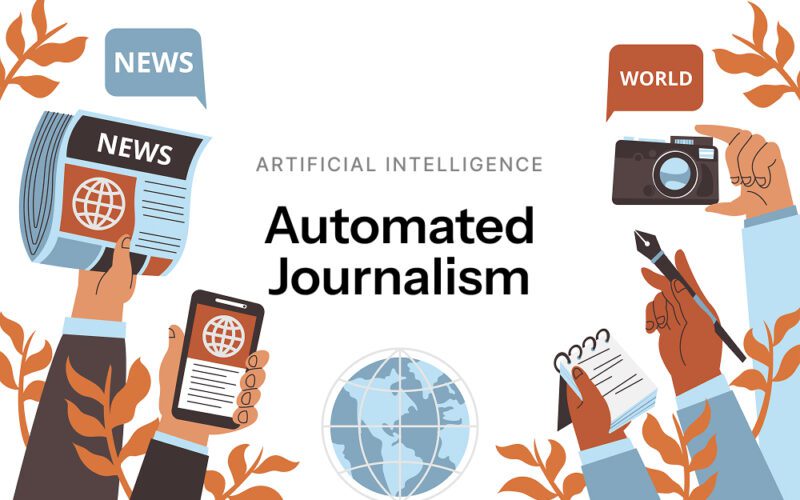News isn’t just written by journalists anymore. Automated journalism—the use of artificial intelligence to generate articles, reports, and updates—has quietly moved from niche experiments to mainstream media production. In 2025, chances are you’ve already read AI-written news without realizing it.
This shift raises important questions: How accurate are these AI-generated reports? Can you trust what you’re reading? And what does it mean for the future of human journalism? Let’s break it down.
What Exactly Is Automated Journalism?
Automated journalism (sometimes called “robot journalism” or “algorithmic reporting”) uses AI to create news articles from raw data or prompts.
Examples you’ve probably seen without noticing:
- Sports recaps generated minutes after a game ends.
- Financial market summaries written automatically after market close.
- Weather and traffic updates refreshed in real-time.
At its best, AI speeds up reporting on repetitive stories, freeing up human journalists to cover deeper investigations. At its worst, it produces generic, error-prone, or even fabricated news that slips past readers.
Why It’s Growing So Fast in 2025
The rise of automated journalism isn’t just about flashy AI. A few big trends are driving adoption:
- Speed & scale: Newsrooms can publish thousands of short updates daily, something impossible with only human staff.
- Cost efficiency: Smaller outlets use AI to cut reporting costs while maintaining round-the-clock coverage.
- AI language improvements: Large language models (LLMs) now produce text that reads almost indistinguishable from human writing.
- Data-rich domains: Sports, finance, and weather rely on structured data, which AI can process and summarize instantly.
Risks You Should Watch Out For
AI in journalism isn’t without serious concerns. Readers need to stay aware of the pitfalls:
1. Accuracy Problems
AI can misinterpret data, confuse timelines, or invent details. Without strong human oversight, misinformation spreads quickly.
2. Lack of Transparency
Many outlets don’t label AI-generated content. You may think you’re reading a human journalist’s work when it’s fully machine-written.
3. Bias Amplification
AI models learn from existing news archives, which means they can reinforce biases, stereotypes, or political leanings.
4. Job Displacement
AI is already replacing entry-level reporting jobs. Critics worry this undermines journalism as a profession.
How to Spot AI-Generated News
While some outlets label AI-written stories, not all do. Here are some telltale signs:
- Repetitive wording or generic phrasing without much nuance.
- Overly fast publishing—a detailed report within seconds of an event.
- Minimal human voice—quotes, context, or analysis may feel shallow or missing.
- Unusual errors—dates, names, or figures slightly off, something a human would normally catch.
How Newsrooms Use Automated Journalism Responsibly
The best media organizations don’t just let AI run unchecked. They follow key safeguards:
- Human-in-the-loop editing: Journalists review and fact-check AI drafts before publishing.
- Clear labeling: Articles tagged with “AI-assisted” or “Automated Report” for reader transparency.
- Narrow use cases: Limiting AI to data-heavy reporting (like earnings reports) instead of investigative stories.
- Ethical frameworks: Internal policies that define when and how AI can be used in reporting.
What Readers Can Do to Stay Informed
You don’t need to abandon digital news, but you do need to be smarter about how you consume it.
Practical Steps
- Check for disclaimers at the top or bottom of the article.
- Cross-reference breaking news on multiple outlets before sharing.
- Prioritize trusted publications that openly disclose their AI use.
- Look for the human element—quotes, analysis, and investigative depth.
The Future of Automated Journalism
Automated journalism isn’t going away. By 2030, experts predict that up to 90% of routine news stories could be AI-generated. But this doesn’t have to mean the end of real journalism.
Smart balance is possible:
- AI handles data-driven stories at scale.
- Human journalists focus on investigations, ethics, and storytelling.
- Readers demand transparency to keep newsrooms accountable.
The future of news isn’t about replacing humans—it’s about making sure AI is a tool, not a substitute for truth.
Bottom line: The next time you read a news update that appeared suspiciously fast, ask yourself—was this written by a journalist, or an algorithm? Being aware is the first step to staying informed in the age of AI-driven media.









